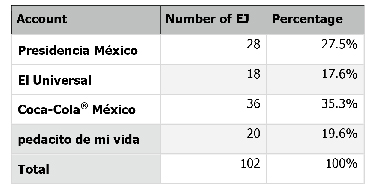
Source: own elaboration.
doi.org/10.15198/seeci.2020.51.129-145
RESEARCH
TRADITION AND INNOVATION IN TWITTER. AN ESSAY OF DISCOURSE TRADITIONS IN MEXICAN AC-COUNTS THROUGH JUNCTION
TRADICIÓN E INNOVACIÓN EN TWITTER. UN ENSAYO DE TRADICIONES DISCURSIVAS EN CUENTAS ME-XICANAS A TRAVÉS DE LA JUNCIÓN
TRADIÇÃO E INNOVAÇÃO NO TWITTER. UM ENSAIO DE TRADIÇÕES DISCURSIVAS NAS CONTAS MEXI-CANAS ATRAVÉS DA JUNÇÃO
Juan-Ricardo Ubiarco-Moya1. Linguist. Master in Humanities from the Universidad Autónoma Metropoli-tana and PhD student at Lingüística
1El Colegio de México A. C. México
ABSTRACT
These lines present some results obtained by testing the hypothesis that suggests the possibility of identi-fying symptoms of a Discourse Tradition -understood as any historically determined mold for communica-tion in a language with its own historicity- in a text through the relative frequency of the junction schemes -elements that connect the propositions in a discourse- that appear in a text. A corpus of 200 Twitter messages was collected, from four accounts corresponding to different spheres of human activity -institutional, commercial, informative and personal-, then an analysis is made in order to find the junc-tion schemes present in the messages, as well as the elements out of linguistic scope, but strongly linked to it. From this, some statistical data is analyzed qualitatively, describing some conservative elements of Discourse Traditions in different spheres, such as the omission of arguments and the use of direct dis-course in the informative sphere, or the diary in the personal sphere. With this analysis, the four spheres can be classified into two groups, following the notion of emission frameworks by Goffman (1981). The conservative elements together with the innovators, allow to postulate the plausibility of a Discourse Tra-dition born on Twitter.
KEY WORDS: discourse traditions, junction, junction schemes, spheres, syntactic integration, semantic complexity, Twitter
RESUMEN
Estas líneas presentan algunos resultados obtenidos sometiendo a la experimentación una hipótesis que sugiere la posibilidad de identificar síntomas de una Tradición Discursiva -entendida como todo molde históricamente determinado para la comunicación en una lengua con su propia historicidad- en un texto a través de la frecuencia relativa de los esquemas de junción -elementos que conectan las proposiciones en un discurso- que aparecen en dicho texto. Se recabó un corpus de 200 mensajes de Twitter, proveniente de cuatro cuentas correspondientes a distintas esferas de actividad humana -institucional, comercial, infor-mativa y personal-, para luego hacer un análisis con el fin de encontrar los esquemas de junción presentes en los mensajes, así como elementos progresivamente alejados de lo lingüístico, pero fuertemente vincu-lados a ello. De esto se obtienen algunos datos estadísticos que luego se someten a interpretación cuali-tativa, describiendo algunos elementos conservadores de Tradiciones Discursivas en distintas esferas, co-mo la omisión de argumentos y el uso del discurso directo en la esfera informativa, o el diario en la esfera personal. Con este análisis, las cuatro esferas se pueden clasificar en dos grupos, siguiendo la noción de marcos de emisión de Goffman (1981). Los elementos conservadores, aunados a los innovadores, permi-ten postular la plausibilidad de una Tradición Discursiva nacida en Twitter.
PALABRAS CLAVE: tradiciones discursivas, junción, esquemas de junción, esferas, integración sintáctica, complejidad semántica, Twitter
RESUME
Apresentamos alguns resultados obtidos submetendo a experimentação uma hipótese que sugere a pos-sibilidade de identificar sintomas de uma Tradição Discursiva – entendida como todo molde historica-mente determinado para a comunicação em uma linguagem com sua própria historicidade – em um texto através da frequência relativa dos esquemas de junção – elementos que conectam as proposições em um discurso – que aparecem no respectivo texto. Se obteve um corpus de 200 mensagens do Twitter, prove-nientes de quatro contas correspondentes a distintas esferas de atividade humana – institucional, comer-cial, informativa e pessoal, para logo fazer uma análise com o fim de encontrar os esquemas de junção presentes nas mensagens, assim como elementos progressivamente distantes do linguístico, mas forte-mente vinculados a ele. Disso se obteve alguns dados estatísticos que logo se submetem a interpretação quantitativa, descrevendo alguns elementos conservadores de Tradições Discursivas em distintas esferas, como a omissão de argumentos e o uso do discurso direto na esfera informativa, ou o diário na esfera pessoal. Com esta análise, as quatro esferas podem se classificar em dois grupos, seguindo a noção de marcos de emissão de Goffmam(1981). Os elementos conservadores, aunados aos inovadores, permitem postular plausibilidade de uma Tradição Discursiva nascida no Twitter.
PALAVRAS CHAVE: tradições discursivas, junção, esquemas de junção, esferas, integração sintática, com-plexidade semântica, Twitter
Correspondence:
Juan Ricardo Ubiarco Moya: El Colegio de México A. C. México.
jubiarco@colmex.mx
Received: 27/04/2019
Accepted: 05/08/2019
Published: 15/03/2020
How to cite the article:
Ubiarco Moya, J. (2020). Tradition and innovation in twitter. An essay of discourse traditions in mexican accounts through junction. [Tradición e innovación en twitter. Un ensayo de tradiciones discursivas en cuentas mexicanas a través de la junción]. Revista de Comunicación de la SEECI, 51, 129-145.
doi: http://doi.org/10.15198/seeci.2020.51.129-145
Recovered from http://www.seeci.net/revista/index.php/seeci/article/view/591
1. INTRODUCTION
The following lines propose a (possible and shallow) analysis of several messages -taken from Twitter microblogging service in Mexican accounts- strongly based on the hypothesis of Kabatek (2005), which has seemed plausible - taking the next step of the scientific method - to put to the test: “The junction schemes of a text -the junctioners it contains and the relative frequency- are symptoms to determine the discursive tradition to which the text belongs” (p. 169).
Every discursive tradition (TD) is related to historically determined ways of speaking (1) and on them he adds elements of innovation: “[…] tradition is always conservative and innovative, and the transformation of a TD into another always consists in traditional elements and new elements, as the email at the begin-ning started from the tradition of the letter” (Kabatek, 2007, p. 341). As Twitter is a relatively new means of communication, which has only been possible due to the development of the Internet and virtual social networks, which add certain possibilities to the universal activity of speech (Coseriu, 1978, p. 45), it is pos-sible -and interesting- to make a study of Twitter messages (tweets), in Mexican Spanish, in the light of TD.
(1) To Coseriu (1981), every language has three levels: universal, historical and individual. Each of them requires different types of knowledge; in the case of the historical level - which is what is discussed here - knowledge of idiomatic rules is required -basically, the grammar of a particular historical language, here Spanish- and of discursive rules, which the study of the TD deals with (Koch, 2008).
The study of linguistic phenomena on the Internet has been a fairly broad field for several years now; in Spanish, some illustrative works are those by Francisco Yus (2010), dedicated to cyberpragmatics, Ana Mancera (2016), who studies sub-standard uses such as identity signs, Vivas and Ridao (2015), who study courtesy on Facebook and Twitter, or Pano and Mancera (2014), about the messages of Spanish politicians on Twitter. In English and on Twitter itself, there are works with tragic and interdisciplinary nuances (O’dea, et al., 2016), about community building from a systemic-functional perspective (Zappavigna, 2011) and more, framed in some degree in twitterology (2).
(2) Zimmer (2011) highlights the fact that Twitter is “a goldmine” for researchers in fields such as linguis-tics, psychology and sociology who are looking for data produced with great immediacy. The combination of transdisciplinary knowledge that can be used to study messages on Twitter has led to encompassing all these types of studies under the concept of twitterology.
The following lines are divided into the following sections: first, the “Objectives” of this little piece of re-search are presented. Then, in “Method” the concept of junction, the quantitative and qualitative parame-ters pertaining to the conformation of the corpus and how the analysis proceeded is written down a little more broadly. The “Discussion” details the junction schemes and their absolute and relative frequencies, and some pertinent examples extracted from the corpus are introduced. Then, some generalizations ob-tained from the analysis are presented in search of elements of conservation and innovation in Twitter messages, in addition to an “act of contrition” due to some methodological decisions taken. Finally, some concise conclusions are drawn on the steps to follow after these first results.
2. OBJECTIVES
For the realization of this first experiment, two objectives have been raised: 1) identify the junction schemes in a corpus ex profeso to outline some indications of TD on Twitter; 2) relate tweets in the cor-pus, from different spheres of human activity, to canonical messages from each of their respective spheres, to suggest some elements of conservation and innovation.
3. METHOD
This study is based on the concept of discursive genres by Bakhtin (1982), “relatively stable types of sen-tences” (p. 248) particular to each sphere of human activity. Within each discursive genre, it is possible to find TD, which are “conventional normative molds that guide the transmission of a sense through linguis-tic elements both in its production and in its reception” (Oesterreicher apud Kabatek, 2007, p. 338). The aim was to identify these “normative molds” with the help of the concept of junction (“Junktion”) that Wolfgang Raible (1992) proposes for typological purposes.
The junction denotes the “elements that relate the propositional components in a text” (Kabatek, 2005, p. 165) and can be analyzed syntactically and semantically. On a vertical axis, syntactic integration is consid-ered, which has seven different degrees, from highest to lowest: I) juxtaposition of sentences; II) anaphora and deixis; III) coordination; IV) subordination; V) constructions with gerund and participle; VI) preposition-al groups (locutions); VII) prepositions; and VIII) actants. On a horizontal axis different levels of semantic complexity are located, which increases following the direction of the writing in Spanish: 1) circumstance (“Begleitumstand”); 2) instrument (“Instrument”); 3) condition (“Bedingung”); 4) temporal relationship (“Zeitrelation”); 5) causality (“Kausalität”); 6) “countercausality” (“Gegenursache”); and 7) purpose (“Fi-nalität”) (Kabatek, 2005, Raible, 1992, 2001, Renwick, 2006).
Bajtín (1982) is not very encouraging to note that the number of discursive genres goes hand in hand with the number of spheres of human activity. So to give feasibility to this piece of research, the proposal of Alcoba (2004) has been partially followed to delimit four spheres of human activity: institutional, informa-tive, commercial and (added from the author) personal. Then a Mexican Twitter account was searched for each of the areas: “Presidencia de México” (@PresidenciaMX), the newspaper “El Universal” (@ El_Universal_Mx), the beverage brand “Coca-Cola® Mexico” (@CocaColaMx) and “pedacito de mi vida” (sic) (@carmenfaroo) represent the accounts of the institutional, informative, commercial and personal spheres, respectively. A corpus formed by 50 messages from each of the four accounts (200 messages in total) was collected, taking October 1, 2018 as the starting date to go back in the timeline. When gather-ing the corpus, tweets from other accounts shared in some of the analyzed accounts were omitted, as well as the “threads” -message strings from one or more users- since we considered they have some ex-tra features as compared to the canonic tweet.
The analysis of junction schemes (EJ) in the corpus focused on the relationships between verbal forms (finite or non-finite), while verbs are considered, if not as a proposition, at least as propositional functions (3). A clarification is made here: in order to make this analysis more manageable, it was decided not to consider all the levels of semantic complexity proposed by Raible (1992), but only three: conditionality, causality and purpose. This type of relationship has been located in the corpus and then the degree of syntactic integration through which they manifest has been noted.
(3) A propositional function is a function that can give its being true or false as values -that is, a proposi-tion- once the arguments it requires are saturated (Kandel, 2008).
4. DISCUSSION
With the parameters defined for the search for EJ - three levels of semantic complexity and eight levels of syntactic integration - a total of 102 EJ were found in the 200 messages of the corpus. Their distribution and the percentage they represent are detailed in Table 1.
Table 1. Distribution of EJ.

Source: own elaboration.
Although the analysis was limited to three levels of semantic complexity, it is clear that others can also be found in the corpus; for example, in (1a) a temporary circumstantial relationship is noticed and in (1b) a modal circumstantial relationship.
1a. #2October | When there was a release all rejoiced, regardless of whether he was a close friend or they did not have any relationship. There was happiness be-cause some were released, but afterward there was sadness for those who stayed (ElUniv-8) (4).
1b. We’ve worked to improve the living conditions of the most vulnerable groups, reducing poverty levels in building an inclusive Mexico: @EPN (Pres-16).
(4) The examples are labeled with a reference to the account from which they were obtained: “Pres” for “Presidencia México”, “ElUniv” for “El Universal”, “Coca” for “Coca-Cola® Mexico”, and “Pedac” for “pedac-ito de mi vida”. The number refers only to the corresponding number in the corpus. It should be added that the writing of all messages has been respected, only by changing the type of font.
Tabla 2. FA of EJ in the corpus.
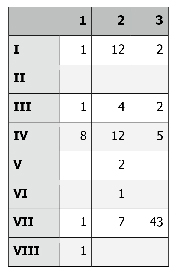
Source: own elaboration.
Table 2 presents the absolute frequency (AF) of the EJ found in the corpus. After a slight revision, the number of EJ VII.3 -purpose expressed by prepositions- stands out. In (2a-d) you can see examples of this scheme of junction taken from each of the accounts:
2a. Executives and operational staff of various Secretariats and departments of @GobMx, are deployed in Sinaloa and Sonora to coordinate with the State Gov-ernments, to help the population affected by the rains (Pres-1).
2b. # AlfombraRoja Arturo López Gavito proposed @_CarlosRivera to the executives of Disney to interpret the theme “Recuérdame” of the film Coco (ElUniv-26).
2c. Make good use of the half-time in Sweden vs England and take one of these in-credible Coca- Cola limited edition T-shirts. Call now and participate to win one! (Coca-12)
2d. If it is being incredible to me how I passed from eagerly wanting to see myself beautiful at the wedding of my friends and get a boyfriend to accompany me as a brainpower to finish all my pending school work. Postgraduate point. I think (Pedac-3).
The EJ of each account are now presented and analyzed briefly. Graph 1 shows the percentages repre-sented by the different EJ found in the “Presidencia Mexico” account. This account also shows the concen-tration of the EJ in type VII.3 -prepositional nucleus in a phrase of final interpretation- leaving the causality expressed by juxtaposition of sentences (I.2) in a very far second place, as in (3), where what is referred to in the first segment indicated with italics can be interpreted as the cause of what is referred to by the second segment.
3. Mexico has acted responsibly in seeking solutions to the challenges of migration. I welcome the progress we have made in reaching a Global Pact for Safe, Orderly and Regular Migration @EPN https://www.gob.mx/presidencia #UNGA (Pres-20)
Graph 2 shows the percentage in which the EJ identified in the “El Universal” account appear. Which, alt-hough with many fewer EJ, follows the trend observed in the previous case as for EJ VII.3. In (4) an exam-ple of EJ IV.2 is presented, subordination meaning causality, the second most common EJ in tweets taken from this account.
4. “I would like to tell those who brought their computer with them that they can-not open it because they have work stuff. That is, it will not help them”, said @margaritacumbia (ElUniv-25).
Graph 3 and Graph 4 show the same information as the first two, now for the “Coca-Cola® Mexico” and “pedacito de mi vida” accounts, respectively. In “Coca-Cola® Mexico” the preeminence of EJ VII.3 (5), can be seen again, now followed by EJ IV.1, conditionality by subordination (5a). Finally, the “pedacito de mi vida” account breaks the trend, leaning towards EJ that show causality by juxtaposition (5b) or by subordi-nation (5c).
(5) The “high” presence of EJ VII.3 in this account may well be due to a very fortuitous event: the presence of the hashtag - a metadata label – “#ListosPara” during the celebration of the last world soccer champi-onship in Russia in the summer of 2018.
Source: own elaboration.
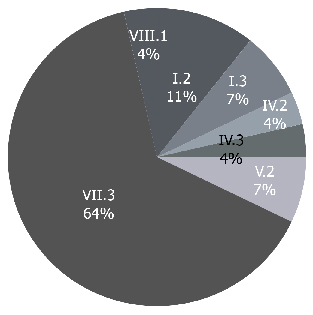
Graph 1. EJ en “Presidencia México”
Source: own elaboration.
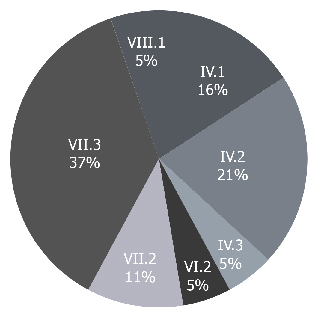
Graph 2. EJ en “El Universal”
Source: own elaboration
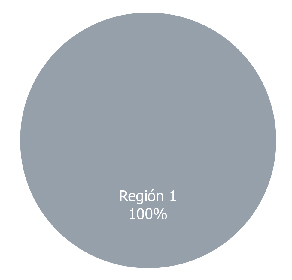
Gráfica 3. EJ en “Coca-Cola® México”
Source: own elaboration.
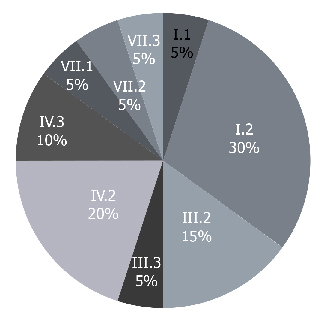
Graph 4. EJ en “pedacito de mi vida”
5a. We are #ListosFor the first quarterfinal match, two great teams face each oth-er. RT if you think France wins and FAV if you support Uruguay (Coca-4).
5b. While we were eating they put on the Jeans. This wedding has already won my crown for best wedding. Sorry not sorry (Pedac-33).
5c. He was stalking the girlfriend of a friend and suddenly I saw this picture and I really do not know if I’m angrier because he is attributed the cobblers that Charly told Borges about STF or because my friend is going out with a girl who thinks it may have been said by Borges (Pedac-23).
The following in this analysis is to present the relative frequency calculation (FR) that Kabatek (2005) re-fers to as symptoms of a TD. Table 3 shows the calculation made to the 102 EJ found in the corpus. Then, Table 4 presents the same calculation, but noted for each of the accounts separately, these tables also show the absolute frequency (FA) of the EJ found.
Table 3. FA and FR of EJ the corpus (1).
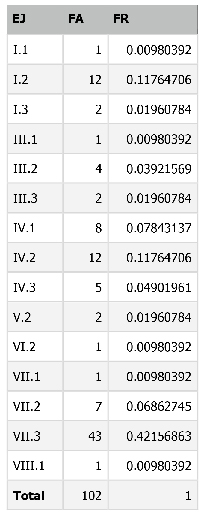
Source: own elaboration.
Table 4. FA and FR of EJ the corpus (2)
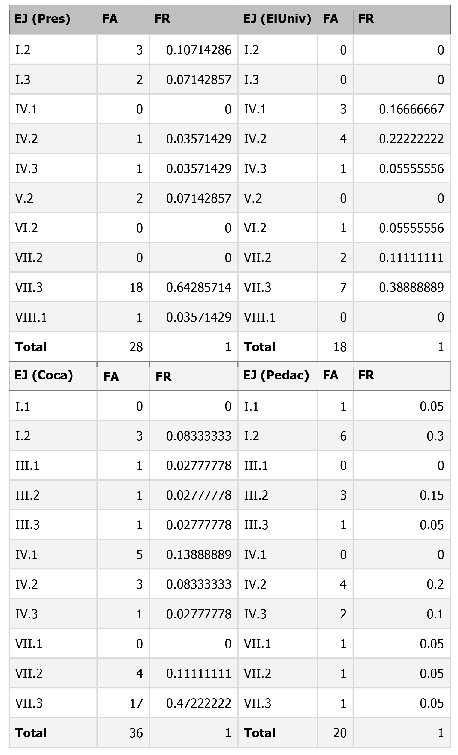
Source: own elaboration.
EJ VIII.3 (the most common) correspond to just over 64% of the EJ in the messages of “Presidencia Méxi-co”, 39% in the “El Universal” newspaper account, and 47% in “Coca-Cola® Mexico”. For its part, EJ I.2 is the most usual in “pedacito de mi vida”, with 30% of the EJ; this account is the one that has a greater dis-tribution among a higher number of types of EJ.
Now, a brief comparison is made, of a rather intuitive nature, of the tweets in the corpus with messages framed in more canonical TD within each of the spheres of action we analyzed, beginning with the institu-tional sphere; the messages within it are used “in state agencies to contribute to the function of adminis-tering incumbent on the authorities and facilitating the provision of services to the community” (Potrero, 2013). The tweets of “Presidencia Mexico” have little similarity with institutional speeches such as that seen in publications of the type of the Official Gazette of the Federation, although this publication corre-sponds rather to a discourse with legal nuances, and much with corporate communication, referring to “all communication resources available to an organization to effectively reach its publics” (Capriotti, 1999, p. 30) in the task of communicating what the corporation makes; this way we can see tweets whose purpose is basically to inform of the activities carried out, mainly, by the president of the republic (6a-b).
6a. As part of the #UNGA, the President @EPN participated in the “High Level Pan-el to build a #EconomíaOceánica #Sustentable” http://ow.ly/2sfK30lXgDT
6b. The President @EPN participated in the discussion @wef on “Sustainable De-velopment at the Fourth Industrial Revolution”, which highlighted the progress made in Mexico to achieve the Goals of #DesarrolloSostenible #ODS #UNGA @SRE_mx @MexOnu @Agenda2030MX
The same informative intention do the tweets of the “El Universal” newspaper account have. In these messages the conservative element of the TD of the newspaper headlines is more easily recognizable. Some formal features identified by Nadal (2012) as characteristic of the newspaper headlines are recur-rent in the tweets of the corpus. Among them, the historical present with omission of arguments (7a-b), the use of direct speech (7c) or noun phrases without determinants (7d).
7a. They ensure that “Black Mirror” returns in December http://eluni.mx/thz1dlkw (ElUniv-11).
7b. UN-DH condemns that the slaughter at Tlatelolco has not been investigated http://eluni.mx/9sejwc46
7c. “You cannot talk about a transfer of the Ministry of Culture if the problems that the workers are not resolved before”, said Ángeles Medina (ElUniv-29, sic).
7d. #Cartón “The weight of the law” by @Helioflores_mex. Here more cartons http://eluni.mx/umza1_zp
It is probably the informative intention that runs through the messages of the two previous accounts and the “Coca-Cola® Mexico” account (the three in which EJ VII.3 predominates), rather than an advertising speech in the latter case. This is seen in many of the tweets in this account that refer to events of social importance -such as music festivals (8a) and sports competitions (8b)-; however, it is possible to find messages (8c) with the persuasive purposes characteristic of the discursive genre of advertising (López, 1999).
8a. Here the official poster of #CocaColaFlowFest, see you on December 8! (Co-ca-47)
8b. Belgium finally stands third and we #ListosPara seeing them celebrate the best position in its history in the FIFA World Cup (Coca-25).
8c. A family, two teams, a table. No matter your colors, soccer tastes better with snack and Coca-Cola #SienteElSabor (Coca-49).
Finally, the relative equilibrium in the distribution of the EJ in “pedacito de mi vida” may well be sympto-matic of the palimpsest that the messages of the personal sphere represent. According to Yus (2010), the purpose of Twitter is for the users, through their messages, to answer questions such as “What are you doing?” or “What happens?”, case shown in (9a). In this account it is also possible to find expression of thoughts (9b) and moods (9c); reference to news, with an “eco” aggregate — some personal assessment of the event— (9d) and, in the same “eco” tenor, fragments of poems (9e) or songs (9f) are retaken. Faced with such heterogeneity, it is only possible to find a distant simile in the personal diary, the mes-sages in a personal Twitter account are somehow a part of the autobiography of the writer.
9a. I read ‘princess’ where it said ‘precious’. What if this is love, what if this is love (?) (Pedac-40).
9b. The latest events have led me to think much of one of the very bad movies fea-turing Karla Souza where they say that love should be easy and I think it should be easy and if not then it is not there (Pedac-22).
9c. Dead inside but a lady outside (Pedac-13).
9d. What a bombshell the one about the tours in the House of the dwarves in the Juarez. What a time to be alive and be from Puebla, the vdd.
9e. “So/no mysterious intentions I know I’ll willingly choose from my old garden only your roses on the tall windows your window of the signs of the sea your sea of things and all the love/your love/Mengana” (Pedac -9).
9f. I woke up well and those of the choir say a gentleman does not leap into space from a first floor does not leap into space from a first floor (Pedac-1).
To conclude this section, the role of hashtags and user codes (introduced by an at) must be mentioned, minimally, perhaps one of the most prominent innovative elements of the use of language on social net-works on the Internet. In a tweet, a hashtag or a user code can play a role in two dimensions: grammati-cal, as an element of the sentence structures specified in a statement, and “cyberpragmatic”, linking the specific sentence with the whole conversation whose topic the hashtag tags or with the user mentioned in a tweet and whose code replaces a proper name. This is exemplified in (10a-b).
10a. Have you seen #ConLosDeEnfrente ? The analysis and debate program of @El_Universal_Mx and @Milenio . With @hdemauleon , @apontedavid , @elisaalanis , @jpbecerraacosta , @azucenau and Carlos Marín, led by @hzamarron . All Wednesdays at 20:30 (ElUniv-27).
10b. In the #UNGA The President @EPN will submit the priorities of Mexico on for-eign policy, as well as an assessment of achievements in multilateral matters achieved during his administration. http://ow.ly/P7nl30lXVD5 @SRE_mx #M é xi-coGlobal (Pres-12).
The FR of the analyzed EJ allow a classification of the four accounts into two groups, based on the de-composition that Goffman (1981) performs on the notion of “speaker” in three roles: “animator”, author and “principal” (6). In the case of three accounts, “Presidencia México”, “El Universal” and “Coca-Cola® México”, it is expected that each of these roles will be played by (groups of) different individuals, one for each role. On the other hand, in a personal account, such as “pedacito de mi vida”, the normal situation is that the three roles fall on the same individual, except, perhaps, in cases such as those just seen (9e-f), in the that the author’s role does not correspond to the owner of the personal account.
(6) Goffman (1981) analyzes the category of “speaker” in a more realistic way, breaking it down into three categories. Thus, this author distinguishes an “animator” - responsible for the physical issuance of the message - an author - behind the selection of ideas, emotions, events, etc., and the linguistic elements that encode them - and a “principal” - which corresponds to the owner of the ideological position repre-sented in the message.
This situation follows the same line as the EJ analysis shown in the previous section, which shows a greater presence of EJ VII.3 in the first three accounts, as well as a slight tendency to EJ I.2 in the personal account, which also shows a wider distribution of EJ in the messages. It is possible to confess that the search for EJ has not been as successful as intended; probably the levels of semantic complexity to which the analysis was restricted also restricted the search results. To this is added that, in Spanish, it could be argued that these semantic relations crystallize canonically in more or less specific constructions: a prepo-sition “for” if you want to indicate purpose, a conjunction “if” to mark conditionality or the conjunction “because” pointing to cause. However, it has been possible to observe some patterns in the tweets that point to some elements of conservation in the TD, the relationship of the tweets of the newspaper “El Universal” with the press headlines being the clearest case.
5. CONCLUSIONS
This last section suggests what seems to be the most fertile way to continue this piece of research. A more finished and ambitious version than the one in this outline could continue to replicate the junction analysis, more completely, in traditional messages of each sphere of action and those partially analyzed here, which would imply the elaboration of a corpus obtained from texts such as newspapers, advertise-ments and personal journals not necessarily limited to Mexican Spanish. This would allow a contrastive study of EJ in the texts of different spheres with a much greater empirical support to test the hypothesis of Kabatek (2005), already mentioned, that has guided this small work.
Despite the small progress this text might seem in relation to the project outlined above, a distinction has been made, through the EJ used in the different texts, between Mexican Twitter accounts belonging to different spheres of action. This linguistic finding correlates, to some extent and so far, as a hypothesis, with different forms of text production, seen with the help of the analytical notions proposed by Goffman (1981).
A final note about innovation in TD: the study of the elements of innovation in TD would go through a more thorough analysis - and aided by theoretical tools that are not available here - of the role of hashtags and audiovisual elements in the search for a better definition of the characteristics of a possible TD born on Twitter (and, in a somewhat general way, with all possible TD in the uses of language on the Internet). Some symptomatic elements of innovation in tweets fall heavily on phenomena that are pro-gressively farther from the strictly linguistic aspect, so they go beyond the limits imposed on this piece of research and those intrinsic to the researcher. The grammatical and “cyberpragmatic” function of hashtags and user codes can be mentioned first. The tweet is also enriched by the possibility that the Twitter service offers to accompany the text with audiovisual elements, whose interaction with the lin-guistic aspect is the cause, for example, of omission of the names of characters involved in the event re-ferred to by the tweet. The same platform offers the opportunity to play with typographic elements, thus creating messages that remember Guillaume Apollinaire’s work.
Thus, among the traditions of the personal diary, the newspaper headline or the advertising message and the play with visual (audio) support codes are some of the elements of innovation and conservation on Twitter.
REFERENCES
AUTHOR:
Juan Ricardo Ubiarco Moya: BA in Spanish Literature from the University of Guanajuato and Humanities teacher at the Autonomous Metropolitan University. I am currently working on my doctoral thesis at El Colegio de México A. C. I am mainly interested in issues of semantics and pragmatics.
jubiarco@colmex.mx
Orcid ID: https://orcid.org/0000-0003-3472-9978